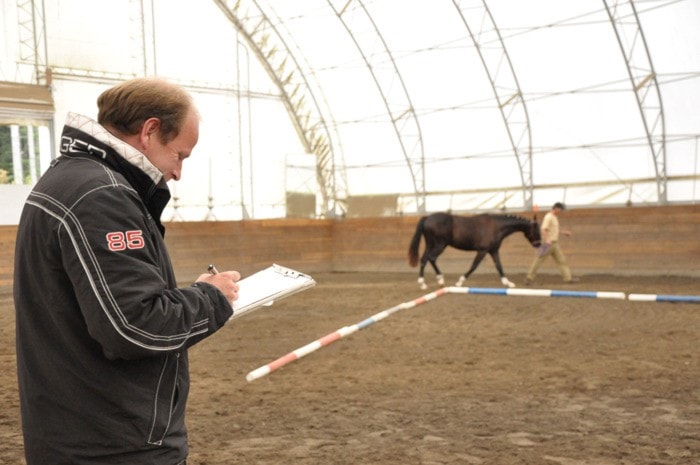Throughout a horse’s life, it may hold a number of jobs.
They could be sailing over fences at Spruce Meadows, performing elegant moves in the dressage ring, blazing through the jumps and forests of an endurance course or simply standing in a field eating grass all day. These are all determined by a wealth of factors, including the horse’s age, physical shape, bloodlines and conformation.
For many warmblood owners and breeders such as Ed and Renate Burns, getting their horses inspected as foals (a male or female horse less than a year old) is a crucial part of determining what job is best for their four-legged friends.
“We breed for dressage and jumping so the goal is an elegant modern-type sports horse,” Ed said.
Once a year, the Burns’ host an Oldenburg N.A. International Sporthorse Registry warmblood mare and foal inspection at their Ladysmith farm, Topnotch Warmbloods. It is currently one of only five Oldenburg inspection sites in Canada.
The foals are inspected by Dr. Christian Schacht, Oldenburg N.A. ISR breeding director, who comes from Germany once a year to inspect and license horses across Canada and the U.S.
“Correct conformation is one of our main breeding goals which is the basis for the soundness and rideability of the horse,” Schacht said. “We score the horses and we can double check whether we have a breeding success. We can give the owners a little bit of advice if it matches the mare and the stallion or whether they better take another stallion, what the main problem or weakness in the mare is, to open their eyes to choose a correct stallion for the horse, to make it easier for them afterwards to sell the horse. If you have an ugly one which is unable to move, nobody wants to buy it.”
In addition to conformation, the foals are also graded on movement, the connection from head to neck, and the appearance of the legs.
“The conformation of the shoulder tells us a little bit whether the horse gets the ability of jumping or whether the horse is more dressage style,” Schacht said. “The frame and topline will also change during the training and the maturity. So it must be harmonic.”
Once a foal passes inspection, it is branded and issued papers, which are crucial for proving the animal’s lineage, markings and age. To receive a premium rating, the foal must score at least 8.0 overall. A premium foal is worth more money and can sell for upwards of $12,000. The value of the horse will then increase with training.
A warmblood, if it is being used for breeding purposes, may go through additional inspections in its lifetime.
“Down the road, temperament is inspected, rideability... it all gets scored,” Renate said. “How the saddle fits, does a horse have a nice wither that goes long into the horse’s back to support the saddle properly, how the hind legs are, are they straight, are the hocks in the right position, are the joints well developed — those are all scored down the road with adult horses.”
Once inspected, the foals at Topnotch farm will either be sold right away as prospects or are kept until they are old enough to start training.
“We wait until they’re three and then we start training them, but we handle them throughout their lives and that way, they’re always nice, gentle animals,” Ed said. “We don’t just pull them off the field and cowboy them up. It’s not as nice.”
There are many different breeds of warmbloods, such as Hanoverians, Westfalens, Trakehners and Holsteiners.
Many of the warmbloods on the market today originate from Europe, where the horses were named after the region they were bred in, Renate said. The Oldenburg is a German breed.
“The warmblood is actually a very heavy breed because it comes from a more cold-blooded horse, from work horses hundreds of years ago. When the industrial revolution happened, they didn’t need those work horses anymore so work horses turned into (light) sport horses,” she explained. “In order to get a heavier horse light, you have to use a light stallion, ergo Arabian or Thoroughbred, and that’s what they’ve done to create the modern warmblood. Thoroughbreds do have certain qualities the warmblood breeding wants, but they have a lot of things they don’t want like the small feet, thin hoof walls, all the common problems we know Thoroughbreds come along with.”
According to Renate, all breeds undergo inspection in Germany, unlike in North America.
“Out of 100 stallions presented, maybe 30 get licensed,” she said. “And they’re usually all very good stallions to begin with... we would all drool over them, but there’s such a large gene pool, they can be more picky.”
Schacht said he is thankful for the opportunity to come to Canada each year to complete the inspections.
“The registry is nothing without the breeders, but the breeders need the registry as well,” he said.
To find out more information on next year’s inspection, which will be held in August 2012, visit www.topnotchwarmbloods.com
